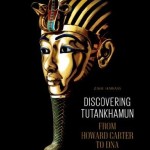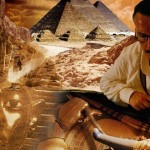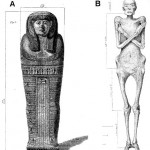
Book Review: “Discovering Tutankhamun – From Howard Carter to DNA” by Zahi Hawass
It is now some while since Zahi Hawass was finally ousted from office as Secretary General of the Supreme Council of Antiquities, following the fall of the Mubarak government in 2011; but his absolute ubiquity on TV programmes concerning ancient Egypt prior to that date (and the fact that these are repeated endlessly on various satellite/cable and terrestrial channels) means that there is little chance of any reader being unaware of his ebullient and bombastic presence. That presence is now reduced to occasional lectures about his former exploits, and adding to the series of published books that bear his name – of which this is the latest. [more…]

The Significance of the Crossed Arms Pose – Part 2: Osiris, The Osiris and the Osirides
Is it a futile activity to ask, as I do in this series of articles, “What is The Significance of the Crossed-Arm Pose?” It might be argued, for instance, that variations in the pose at death exhibited by royal mummies simply reflect what embalmers decided to do on the day, or at least the customary practice of a particular undertaker. Similarly, it might be argued that each individual anthropoid coffin might be expected to reveal some unique design characteristic, and that no significance should be attached to the specific hand/arm pose depicted on the lid. [more…]
Edition - November, 2013

Overview of the BBC’s “Egypt – The Search for Tutankhamun”
By Andrea Byrnes and Dylan Bickerstaffe. Published on In Brief, 14th November 2013. Egypt: Series 1 – 1. The Search for Tutankhamun Part 1 of a six-part series by the BBC Director – Ferdinand Fairfax Executive Producer – Phil Dolling Series Producer – Paul Bradshaw Writer – Tony Mulholland Narrator – Andrew Sachs Described as […] [more…]

The Significance of the Crossed Arms Pose in the New Kingdom – Part 1
Amongst the many miracles through which delicate objects are preserved from ancient Egypt down into modern times, perhaps the most remarkable is the survival of the mortal remains of a virtually complete sequence of New Kingdom rulers. These kings, along with a number of queens and lesser royalty – who date from the end of the Seventeenth Dynasty through to the start of the Twenty-Second Dynasty – are generally referred to as the Royal Mummies, and were for the most part recovered from the Royal Cache of 1881 (in tomb TT320), and the Second Royal Cache of 1898 (in tomb KV35, the tomb of Amenhotep II). [more…]
 By
By